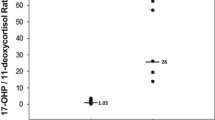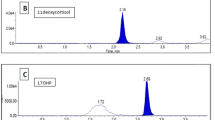Abstract
Precursor-to-product ratios in steroid hormone metabolism may accurately reflect enzymatic activity and production of metabolites relative to their disappearance. The purpose of this study was to explore the use of direct precursor-to-product steroid ratios to discriminate between infants with congenital adrenal hyperplasia (CAH) due to 21-α-hydroxylase deficiency and infants with no disorder, thus characterizing the biochemical phenotype in CAH. Deidentified dried blood spot samples from confirmed CAH cases identified by newborn screen (CAH-positive, N = 8) and from cases with no disorder (CAH-negative, N = 10) were obtained from the California State Newborn Screening Program. Samples (~6.25 mm circular spots) underwent methanol and water extraction (9:1 ratio). Deuterated steroids served as isotope internal standards. 17-α-hydroxyprogesterone (17-OHP), 11-deoxycortisol (S), androstenedione (A4) and cortisol (F) concentrations were determined by liquid chromatography–tandem mass spectrometry (LC–MS/MS), and the 17-OHP/S, 17-OHP/A4, and S/F ratios were calculated. The mean 17-OHP and A4 concentrations in samples from CAH cases were significantly increased when compared to cases with no disorder (p = 0.003 for both). 17-OHP/S and 17-OHP/A4 ratios were also significantly elevated in CAH cases (p = 0.007 and p < 0.001, respectively). In contrast, S and F concentrations and the S/F ratio were similar between the two groups. In CAH, the elevated 17-OHP/S ratio is a biomarker of diminished 21-α-hydroxylase activity, and the elevated 17-OHP/A4 ratio is a biomarker of adrenal androgen excess via increased 17,20-lyase activity. The similar S/F ratio indicates that the rate of production via 11-β-hydroxylase and disappearance of F is maintained in CAH.



Similar content being viewed by others
Notes
The steroid concentrations are presented as ng/mL and nmol/L, the conventional unit of measure used by the Newborn Screening Program in California.
References
Dhillon, K., Ho, T., Rich, P., Xu, D., Lorey, F., She, J., et al. (2011). An automated method on analysis of blood steroids using liquid chromatography tandem mass spectrometry: application to population screening for congenital adrenal hyperplasia in newborns. Clinica Chimica Acta, 412(23–24), 2076–2084.
Ersch, J., Beinder, E., Stallmach, T., Bucher, H. U., & Torresani, T. (2008). 17-Hydroxyprogesterone in premature infants as a marker of intrauterine stress. Journal of Perinatal Medicine, 36(2), 157–160.
Fingerhut, R. (2009). False positive rate in newborn screening for congenital adrenal hyperplasia (CAH)-ether extraction reveals two distinct reasons for elevated 17alpha-hydroxyprogesterone (17-OHP) values. Steroids, 74(8), 662–665.
Finkielstain, G. P., Chen, W., Mehta, S. P., Fujimura, F. K., Hanna, R. M., Van Ryzin, C., et al. (2011). Comprehensive genetic analysis of 182 unrelated families with congenital adrenal hyperplasia due to 21-hydroxylase deficiency. Journal of Clinical Endocrinology and Metabolism, 96(1), E161–E172.
Health CDoP. (2012). Endocrine diseases. Newborn screening program: State of California.
Hicks, R. A., Ferreira, B. F., Mao, C. S., Yee, J. K., & Lee, W.-P. (2012). The use of 17-α-hydroxyprogesterone to 11-deoxycortisol ratio in newborn screening of congenital adrenal hyperplasia. Journal of Clinical Investigation, 60, 222.
Hingre, R. V., Gross, S. J., Hingre, K. S., Mayes, D. M., & Richman, R. A. (1994). Adrenal steroidogenesis in very low birth weight preterm infants. Journal of Clinical Endocrinology and Metabolism, 78(2), 266–270.
Holst, J. P., Soldin, S. J., Tractenberg, R. E., Guo, T., Kundra, P., Verbalis, J. G., et al. (2007). Use of steroid profiles in determining the cause of adrenal insufficiency. Steroids, 72(1), 71–84.
Janzen, N., Peter, M., Sander, S., Steuerwald, U., Terhardt, M., Holtkamp, U., et al. (2007). Newborn screening for congenital adrenal hyperplasia: additional steroid profile using liquid chromatography–tandem mass spectrometry. Journal of Clinical Endocrinology and Metabolism, 92(7), 2581–2589.
Joint, L. E. C. A. H. W. G. (2002). Consensus statement on 21-hydroxylase deficiency from the Lawson Wilkins Pediatric Endocrine Society and the European Society for Paediatric Endocrinology. Journal of Clinical Endocrinology and Metabolism, 87(9), 4048–4053.
Jopling, J., Henry, E., Wiedmeier, S. E., & Christensen, R. D. (2009). Reference ranges for hematocrit and blood hemoglobin concentration during the neonatal period: data from a multihospital health care system. Pediatrics, 123(2), e333–e337.
Lacey, J. M., Minutti, C. Z., Magera, M. J., Tauscher, A. L., Casetta, B., McCann, M., et al. (2004). Improved specificity of newborn screening for congenital adrenal hyperplasia by second-tier steroid profiling using tandem mass spectrometry. Clinical Chemistry, 50(3), 621–625.
Matern, D., Tortorelli, S., Oglesbee, D., Gavrilov, D., & Rinaldo, P. (2007). Reduction of the false-positive rate in newborn screening by implementation of MS/MS-based second-tier tests: the Mayo Clinic experience (2004–2007). Journal of Inherited Metabolic Disease, 30(4), 585–592.
Minutti, C. Z., Lacey, J. M., Magera, M. J., Hahn, S. H., McCann, M., Schulze, A., et al. (2004). Steroid profiling by tandem mass spectrometry improves the positive predictive value of newborn screening for congenital adrenal hyperplasia. Journal of Clinical Endocrinology and Metabolism, 89(8), 3687–3693.
Mitchell, M. L., & Hermos, R. J. (1998). Cortisol in dried blood screening specimens from newborns with raised 17-hydroxyprogesterone and congenital adrenal hyperplasia. Clinical Endocrinology (Oxf), 48(6), 757–760.
Peter, M., Sippell, W. G., Lorenzen, F., Willig, R. P., Westphal, E., & Grosse-Wilde, H. (1990). Improved test to identify heterozygotes for congenital adrenal hyperplasia without index case examination. Lancet, 335(8701), 1296–1299.
Sarafoglou, K., Banks, K., Gaviglio, A., Hietala, A., McCann, M., & Thomas, W. (2012). Comparison of one-tier and two-tier newborn screening metrics for congenital adrenal hyperplasia. Pediatrics, 130(5), e1261–e1268.
Soldin, S. J., & Soldin, O. P. (2009). Steroid hormone analysis by tandem mass spectrometry. Clinical Chemistry, 55(6), 1061–1066.
Speiser, P. W., Azziz, R., Baskin, L. S., Ghizzoni, L., Hensle, T. W., Merke, D. P., et al. (2010a). Congenital adrenal hyperplasia due to steroid 21-hydroxylase deficiency: an Endocrine Society clinical practice guideline. Journal of Clinical Endocrinology and Metabolism, 95(9), 4133–4160.
Speiser, P. W., Azziz, R., Baskin, L. S., Ghizzoni, L., Hensle, T. W., Merke, D. P., et al. (2010b). Congenital adrenal hyperplasia due to steroid 21-hydroxylase deficiency: an Endocrine Society clinical practice guideline. Journal of Clinical Endocrinology and Metabolism, 95(9), 4133–4160.
White, P. C. (2009). Neonatal screening for congenital adrenal hyperplasia. Nature Reviews Endocrinology, 5(9), 490–498.
Acknowledgments
We would like to thank Maria Lajoie and Shu Lim of the CTSI Core Laboratory for their technical assistance, and Seyed Sadjadi of Phenomenex for his help in optimizing the LC–MS/MS method. Steroid analyses were performed at the Biomedical Mass Spectrometry facility at the Los Angeles Biomedical Research Institute at Harbor-UCLA, which is partly supported by the University of California Los Angeles Clinical and Translational Science Institute (UL1 TR000124) and the Metabolomics core of the Center of Excellence for Pancreatic Diseases (P01 AT003960).
Author information
Authors and Affiliations
Corresponding author
Rights and permissions
About this article
Cite this article
Hicks, R.A., Yee, J.K., Mao, C.S. et al. Precursor-to-product ratios reflect biochemical phenotype in congenital adrenal hyperplasia. Metabolomics 10, 123–131 (2014). https://doi.org/10.1007/s11306-013-0558-1
Received:
Accepted:
Published:
Issue Date:
DOI: https://doi.org/10.1007/s11306-013-0558-1




